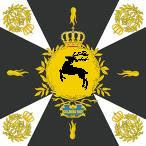With painting proceeding apace on the 'lead mountain', I can turn my attention to the upcoming campaign. I am planning to have a more varied terrain than before, with the two armies scattered it into various smaller groups. This may make a big 'all units on the table' battle less likely in the campaign, but it should allow for lots of more varied fighting as various sub-commanders march around. I'm aiming to get a campaign focused more on Luftberg, and specifically the internal rivalries of it's characters. Fighting Aschenbach might be the day-job, but with your back-biting rivals all around you, this internecine fight is
personal!
With this in mind, plus the upcoming chance of more independent action, it's probably a good idea to look over who our various personalities are - and consider how their standing has been altered by the conclusion of the Spitzplatz campaign.
Elector Ulrich Von Luftberg is top of the heap, absolute ruler of Luftberg in perpetuity, etc. etc. He did not take part in the recent Spitzplatz campaign, due to it being effectively being engineered and run by Felix Von Hentsch. However, his previous outing saw him win the major battle of Vogelhof, still the greatest battlefield defeat that Aschenbach have ever taken. In fact, he won the whole war and took over the whole province for Luftberg following a successful siege back in 2008 (well, whatever the imagiNation year-equivalent is!) He'll get brought out of his semi-retirement to command the national army again, putting personal reputation on the line once more.
Graf Felix Von Hentsch is the embodiment of supreme evil, coldly plotting to usurp the Electorate for the Von Hentsch family. As his own dynasty seemed like the only alternative to the ruling family, marrying into the royal house looked like a sure thing as long as no rivals appeared and Von Hentsch prestige remained high. Sadly for his plots, the Spitzplatz campaign came along. In the campaign, Von Hentsch aimed to loot the five cities in the province to ruin the newcomer Von Bitzhelm family. He only managed two of the five, which means that the Von Hentsch clan now has a rival to deal with. Plus, although he managed to snatch a stalemate at the end of the campaign, he lost several pitched battles to the Aschenbach army, rather tarnishing his self-proclaimed reputation as a military genius. Still plotting away, Von Hentsch is a man with enemies to destroy and a reputation to restore.
Graf Karl Von Bitzhelm is the dynastic ruler of Spitzplatz, and his family are famous for being vastly wealthy and ugly - the classic 'arrogant noble'. Although the campaign through his lands didn't kill off Aschenbach claims to it (and probably guarantees a later campaign will need to be fought,) his siding with Luftberg meant he is now highly politically favoured - much to Von Hentsch's annoyance. He's never taken the field before, but really - how difficult can it be? If that villainous Von Hentsch can do it while stealing off the Von Bitzhelms, then surely it can't be that hard!
Freiherr Tobias Ludwig is the most junior of the quartet, who shot to prominence during the Spitzplatz campaign. The great-nephew of the Tradgardland Duke, he arrived mid-campaign
and proceeded to give Luftberg's military some of it's best moments. He even led a semi-suicidal attack at the battle of Froschbach, and with the aggressive cockiness he's famous for, he doubtless believes that if he'd been given a more senior role he could've saved the whole battle for Luftberg. Clearly valued as a subordinate by Von Hentsch, it's unlikely that Ludwig sees it in quite those terms.
So, four various commanders for the upcoming campaign - all of whom like some but hate most. The summary breakdown runs as:
Luftberg likes Bitzhelm (rich, plus guarantees Spitzplatz to Luftberg); hates Von Hentsch (plotter, and nearly lost the war); and dislikes Ludwig (jumped-up swaggerer!)
V. Hentsch likes Ludwig (trusty second-in-command); hates Luftberg (as he wants his throne); and hates Bitzhelm (his rival to power.)
Bitzhelm likes Luftberg (his new political ally), likes Ludwig (arrogant aristocrat, so a kindred spirit); and hates Von Hentsch (he plundered his cities for his own wealth!)
Ludwig likes Luftberg (the head of his adoptive homeland); hates Von Hentsch (who should have resigned his command and given him the army) and hates Von Bitzhelm (older, uglier, and a new rival to this military glory-hog!)
It's worth noting that the above wasn't really 'written' by me - the relationships just seemed to form up that way as the named leaders marched around and played out the battles. It's a nice sign of things taking on a life of their own. How this dysfunctional crew will function when Aschenbach comes calling remains to be seen, but it should be "interesting" if nothing else!




